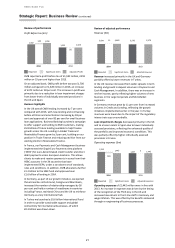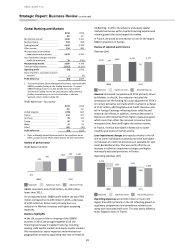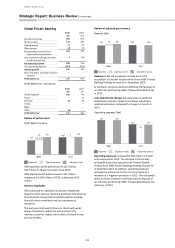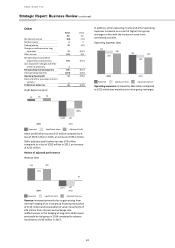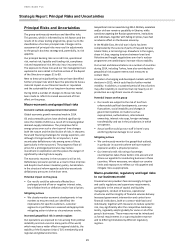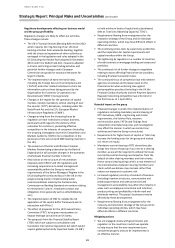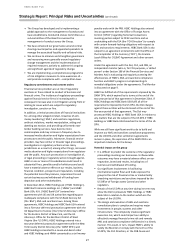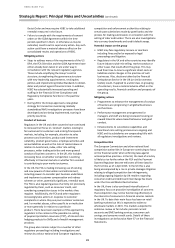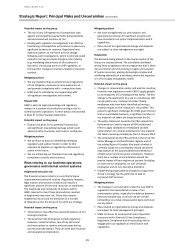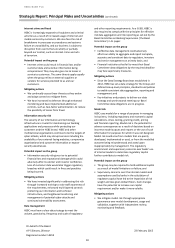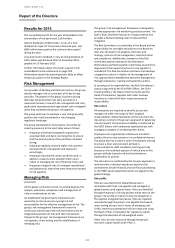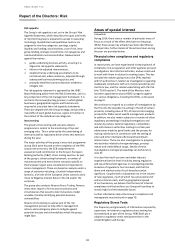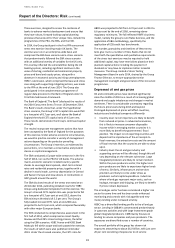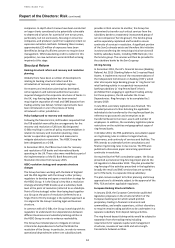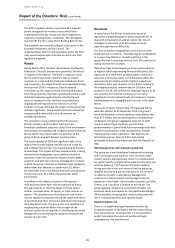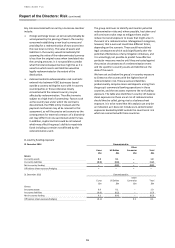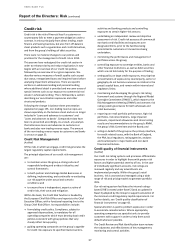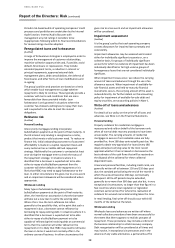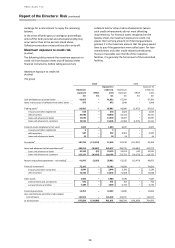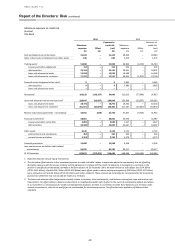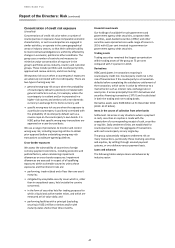HSBC 2014 Annual Report Download - page 33
Download and view the complete annual report
Please find page 33 of the 2014 HSBC annual report below. You can navigate through the pages in the report by either clicking on the pages listed below, or by using the keyword search tool below to find specific information within the annual report.
HSBC BANK PLC
Report of the Directors
31
Results for 2014
The consolidated profit for the year attributable to the
shareholders of the bank was £1,354 million.
Interim dividends of £630 million, in lieu of a final
dividend in respect of the previous financial year, and
£600 million were paid on the ordinary share capital
during the year.
A second interim dividend, in lieu of a final dividend, of
£315 million was declared after 31 December 2014,
payable on 25 February 2015.
Further information about the results is given in the
consolidated income statement on page 105.
Information about future developments likely to affect
the group is given in the Strategic Report.
Risk Management
As a provider of banking and financial services, the group
actively manages risk as a core part of its day-to-day
activities. The growth in the group’s business during
2014 was achieved while risks were assumed in a
measured manner in line with the risk appetite and risks,
particularly reputational and operational, were mitigated
when they exceeded the group’s risk appetite.
The group continues to maintain a very strong liquidity
position and is well positioned for the changing
regulatory landscape.
The group maintained its conservative risk profile by
reducing exposure to the most likely areas of stress:
• the group selectively managed its exposure to
sovereign debt and bank counterparties to ensure
that the overall quality of the portfolio remained
strong;
• the group regularly assessed higher risk countries
and adjusted its risk appetite and exposures
accordingly;
• the group repositioned certain portfolios and, in
addition, made its client selection filters more
robust in managing the risk of financial crime; and
• the group mitigated risks, for example reputational
and operational, when they were forecast to exceed
its risk appetite.
Managing Risk
(Unaudited)
All the group’s activities involve, to varying degrees, the
analysis, evaluation, acceptance and management of
risks or combinations of risks.
An established risk governance framework and
ownership structure ensures oversight of and
accountability for the effective management of risk. The
group’s risk management framework fosters the
continuous monitoring of the risk environment and an
integrated evaluation of risks and their interactions.
Integral to the group’s risk management framework are
risk appetite, stress testing and the identification of
emerging risks.
The group’s risk management framework is designed to
provide appropriate risk monitoring and assessment. The
bank's Risk Committee focuses on risk governance and
provides a forward-looking view of risks and their
mitigation.
The Risk Committee is a committee of the Board and has
responsibility for oversight and advice to the Board on,
inter alia, the bank’s risk appetite, tolerance and
strategy, systems of risk management, internal control
and compliance. Additionally, members of the Risk
Committee attend meetings of the Chairman’s
Nominations and Remuneration Committee at which the
alignment of the reward structures to risk appetite is
considered. The Risk Committee maintains and develops
a supportive culture in relation to the management of
risk, appropriately embedded by executive management
through procedures, training and leadership actions.
In carrying out its responsibilities, the Risk Committee is
closely supported by the Chief Risk Officer, the Chief
Financial Officer, the Head of Internal Audit and the
Head of Compliance, together with other business
functions on risks within their respective areas of
responsibility.
Risk culture
All employees are required to identify, assess and
manage risk within the scope of their assigned
responsibilities. Global Standards set the tone from the
top and are central to the group’s approach to balancing
risk and reward. Personal accountability is reinforced by
the HSBC Values, with employees expected to act with
courageous integrity in conducting their duties.
Employees are supported by a disclosure line which
enables them to raise concerns in a confidential manner.
The group also has in place a suite of mandatory training
to ensure a clear and consistent attitude is
communicated to staff; mandatory training not only
focuses on the technical aspects of risk but also on the
group’s attitude towards risk and the behaviours
expected by its policies.
The risk culture is reinforced by the Group’s approach to
remuneration; individual awards are based on the
achievement of both financial and non-financial (relating
to the HSBC Values) objectives which are aligned to the
global strategy.
Risk profile
Risks are assumed by the Global Businesses in
accordance with their risk appetite and managed at
global business and regional levels. Risks are identified
through the group’s risk map process which sets out the
group’s risk profile in relation to key risk categories in
the regional and global businesses. Risks are regularly
assessed through the group’s risk appetite framework,
stress testing process and in terms of emerging risks.
Credit, market and operational risk are measured using
the Basel 2 Pillar 1 framework for regulatory capital
through the allocation of risk-weighted assets
Other risks are also measured through the group’s
economic capital model under Pillar 2.


